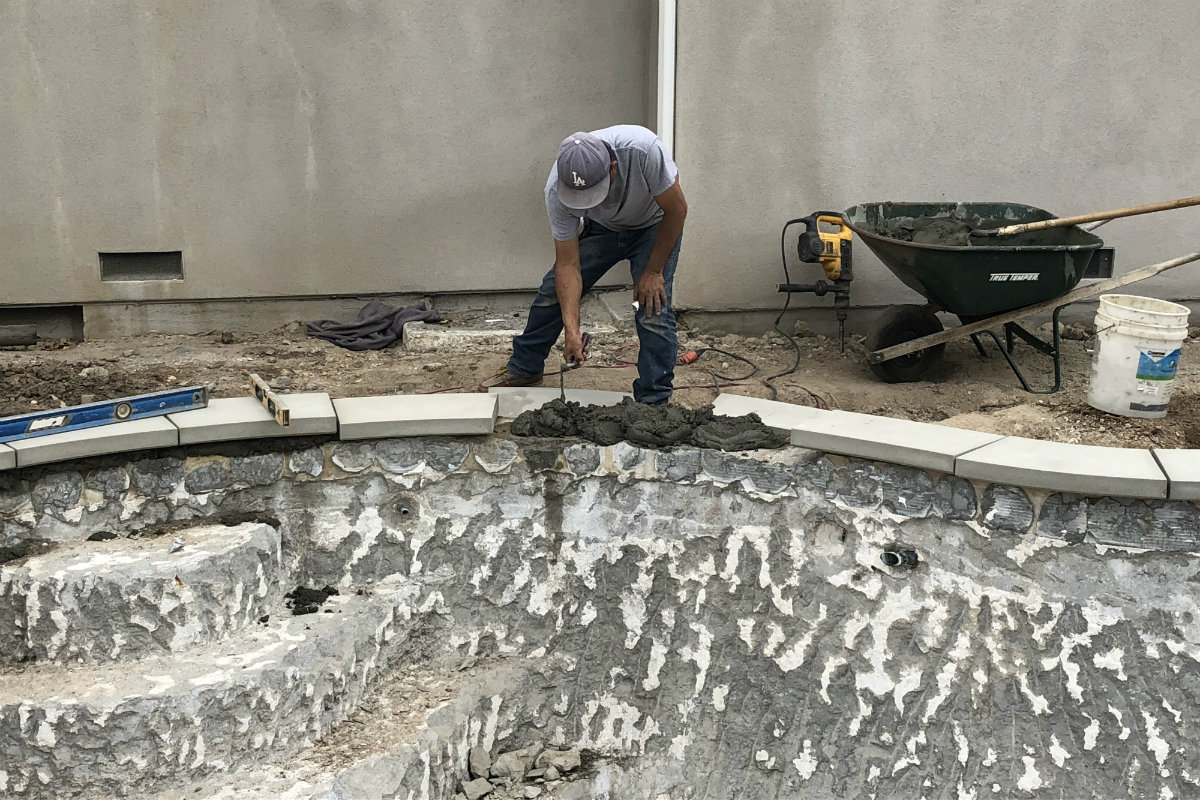The first person a homeowner will approach about renovating their pool isn’t a plasterer or tile expert. It’s the one who’s been diligently maintaining their equipment and balancing their chemicals week after week.
In many cases, the service professional is the first point of contact in a five-figure renovation project. For multi-disciplinary firms, the maintenance crew serves as a reliable sales channel for the construction team.
“I get a lot of calls from our service group,” says Kimo Davidson, sales manager at Aloha Pools and Spas of Union City, Tenn. “They’ll tell me about a customer who wants a new plaster job or maybe a hot tub.”
That puts the single poler in a bit of a predicament. Without a construction department to forward these requests to, does he pass on the job or do it himself?
Maintenance pros seem to be finding themselves in this position with increasing frequency. Consider that many of the pools built before 1990 are practically screaming for makeovers. Tiles are falling off, plaster is spalling, weeds are sprouting in the expansion joints, and the coping has seen better days.
By all accounts, the renovation market is white hot.
“They’ve been building pools here since the ’70s, and those pools are starting to come up for complete renovations,” says Steve Rosales, lead designer and renovation consultant at Imperial Pools and Designs in Tucson, Ariz.
By some estimates, remodels and renovations might be larger than the new-build market. Some of this, professionals say, is driven by improved real estate conditions. Sellers are giving their pools facelifts before listing their properties. Likewise, home buyers are modernizing aging pools with automation equipment, sun shelves and waterfeatures.
“A lot of times, someone will buy a new home and maybe the pool was not kept up during the sales process, or perhaps it was a foreclosure,” Davidson says. “That is a huge renovation area.”
Further fueling interest in this arena is the fact that some regions are oversaturated with Chuck-in-a-Truck service techs. Those seeking to differentiate themselves are trying to broaden their skills beyond chemistry and equipment repairs. To do this, they’re enrolling in introductory courses in construction that have proven popular at trade shows.
From single poler to construction super
Generally, a service technician can ease into renovations by replacing equipment and installing handrails, diving boards, slides and plug-and-play waterfeatures. But once you begin demolishing the structure, now you’re renovating, and you may find yourself in over your head. So while the opportunity is ripe for more skilled professionals, the risk is great.
“It’s a completely different animal in terms of licensing, insurance and training from what they’ve done before,” cautions David Peterson, president and CEO of Watershape Consulting in Solana Beach, Calif.
Even though you’ll likely subcontract much of the work out, you should still know enough about construction and structural engineering to keep yourself out of hot water. After all, the pool technician in this position will essentially serve as a project manager orchestrating the work of three or four other trades, such as the plasterer, mason, plumber and electrician.
It’s easy to get into a renovation project and discover big problems along the way.
A common pitfall can happen like this: You’ve hired a plastering company to apply a new interior. As the crew chips out the old plaster, they discover that the original builder formed the stairs and benches with rebound — the junky byproduct of the shotcrete process. Lazy builders sometimes use the unstable, cement-coated aggregate as infill, causing stairs and benches to crack.
If you don’t know what to look for, you may inadvertently plaster over the bad shotcrete. You could be held responsible for any defects that may occur later. As Peterson warns, “the last person to touch a project owns it.”
In these circumstances, the solution would be to rip out the defective stairs and benches and cast or shoot new concrete. Be sure to get a change order so the added work doesn’t eat into your profits.
Stay abreast of code changes too. You don’t want to be caught flatfooted if your electrical contractor isn’t up to speed on the latest in equipotential bonding practices. And God forbid someone is electrocuted in the pool. Claiming ignorance in electrical matters won’t hold up in court, experts warn.
Figuring finances
The finances for these projects are more complicated than issuing monthly service bill. You’ll need to compare quotes and find reputable contractors who won’t cut corners, which will cost you in the long run. You’ll determine your mark-up — generally somewhere around 35%. Then it’s a matter of protecting your profit.
There are several of ways to do this. One is to enter into a cost-plus agreement with your customer. That’s your management fee on top of materials and labor. If changes occur during the process, such as when the homeowner changes a material or wants to add a feature, the customer expects to pay according to this formula. If you should run into unforeseen circumstances — say you’ve discovered thin concrete in the vessel and need to hire a shotcrete company for a redo — that added cost won’t come out of your fee.
Another way is to factor a contingency into your cost. In this scenario, you’re padding your fee to cover unanticipated expenses. If all goes well, you can pocket that money.
A third option is to get the customer to agree to set aside around 20% of the total estimated cost to pay for any surprises that may be unearthed during the reno. As the project progresses without incident, that amount can dwindle incrementally from phase to phase.
Contractors must pay their subs in a timely fashion after the work is completed, following any state or local codes and laws that apply.
No matter which way you approach it, be prepared to be hands on. You can’t simply hire a crew and turn a blind eye to the proceedings.
Says Peterson: “You shouldn’t tiptoe into this. You’re either all in or you should stay out.”
Renovation resources
Before you begin tackling your first big renovation, spend a little time in class.
Industry organizations have developed courses specifically designed for service professionals who want to transition to construction.
Earlier this year at the Northeast Spa and Pool Association’s trade show in Atlantic City, maintenance technicians received hands-on training for tile and coping repairs for the first time. Instructor Jeff McGalliard says NESPA felt the curriculum was needed because many masons will pass on smaller jobs or charge outrageous fees, leaving service techs to figure out the task for themselves.
“If you’re looking to repair 3 or 4 feet of tile, the tile and coping guys are going to charge you $500 or better,” says McGalliard, co-owner of Premier Pools and Spas in Souderton, Penn.
At that rate, there isn’t much profit to be made.
With a little training, techs can make minor repairs themselves.
“We’re trying to make it a little bit more professional by giving them a nice starting point,” McGalliard adds.
The class was a hit and NESPA is now planning to offer it several times throughout the year at its Hamilton, N.J. headquarters, in addition to next year’s Pool & Spa Show.
For a deeper dive into the renovation arena, Genesis offers Construction 281, a two-day course that provides an overview of construction fundamentals, as well as in-depth design exercises.
The curriculum also offers practical instruction on project management and how to assess a pool’s structural integrity and mechanical system.
Ultimately, they’ll learn how to turn a simple request for a $20,000 facelift to a $200,000 outdoor-living haven.
The class was offered earlier this year at the Western Pool and Spa Show in Long Beach, Calif. More are planned for later in the year.



